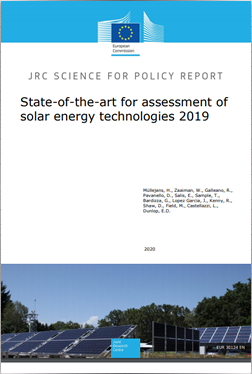State-of-the-art for assessment of solar energy technologies 2019
This publication is a Science for Policy report by the Joint Research Centre (JRC), the European Commission’s science and knowledge service. It aims to provide evidence-based scientific support to the European policymaking process.
The Joint Research Centre (JRC) operates the European Solar Test Installation (ESTI) that develops expertise for state-of-the-art assessment of electrical performance of PV devices based on traditional as well as emerging PV technologies.
Abstract
To realize the EU target of energy transition to a carbon neutral energy system, wide scale deployment of photovoltaic solar energy is required. This report describes the contribution of the European Solar Test Installation to enable this transition.
Executive summary
Photovoltaics (PV) are expected to make a major contribution to achieving European and global climate change mitigation goals over the coming 30 years. PV is the renewable energy technology with the largest scope for cost reduction and efficiency gains, as well as exploiting the largest resource.
Key conclusions
The PV sector requires accurate and reliable assessment of electrical performance of PV modules. Due to the high-tech character and the innovative aspect, this requires that calibration laboratories, such as ESTI, provide assessment of the performance to be used as reference values by the PV industry. To keep up with the development of the PV sector, this requires the laboratories to improve further the accuracy of PV performance measurement as well as to develop new measurement procedures for emerging PV technologies.
One key aspect is to extend from the traditional measurement of output power of PV modules to a metric related to their energy production when deployed in the field.
Furthermore research and development of measurement methods is urgently needed, accompanying the development of new PV products, be it new concepts (such as bi-facial PV modules) or new PV technologies (such as perovskite solar cells). Often the PV industry can have products in the market faster than the respective measurement technology is developed. This is because the pre-normative research and the following standardisation process requires typically several years, whereas some new technologies such as bifacial PV modules appear quickly in the market. Indeed, modern crystalline-silicon PV modules are inherently sensitive to light from both sides (i.e. bi-facial). A new PV product can easily be created by only changing the rear side cover of a crystalline-silicon PV module from standard opaque material to transparent glass. In the absence of published international standards for advanced measurement of PV devices, it is very important for both manufacturers and legislators to have full availability of experienced reference laboratories, such as ESTI, which can provide official performance assessment based on their expertise and under an accreditation scheme.
Details
- Source: EU Science Hub
- Source Link: https://ec.europa.eu/jrc/en
- Publisher(s): Publications Office of the European Union
- Publication Date: 04/2020
- Language: English
- ISBN: 978-92-76-17159-1
- Online ISSN: 1018-5593
